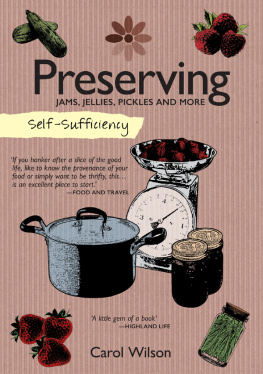Contents
Guide
Self-sufficiency
Preserving


Self-sufficiency
Preserving
JAMES, JELLIES, PICKLES AND MORE

Carol Wilson

Published 2016IMM Lifestyle Books
www.IMMLifestyleBooks.com
IMM Lifestyle Books are distributed in the UK by Grantham Book Service.
In North America, IMM Lifestyle Books are distributed by
Fox Chapel Publishing
1970 Broad Street
East Petersburg, PA 17520
www.FoxChapelPublishing.com
Copyright 2009, 2016 text: Carol Wilson
Copyright 2009, 2016 illustrations: IMM Lifestyle Books
Copyright 2009, 2016 IMM Lifestyle Books
Carol Wilson has asserted her moral right to be identified as the author of this work.
All rights reserved. No part of this publication may be reproduced, stored in a retrieval system or transmitted in any form or by any means, electronic, mechanical, photocopying, recording or otherwise, without the prior written permission of the publishers and copyright holders.
eISBN 978 1 6076 5256 4
10 9 8 7 6 5 4 3 2 1
Printed in Singapore
The author and publishers have made every effort to ensure that all information given in this book is safe and accurate, but they cannot accept liability for any resulting injury or loss or damage to either property or person, whether direct or consequential or however arising.
CONTENTS

INTRODUCTION
Theres something very satisfying about opening a cupboard and surveying the splendid rows of gleaming glass jars filled with homemade jams, jellies, chutneys pickles and bottled fruits. It always gives me a warm glow of achievement to know that all these delicious preserves are homemade from garden produce if not my own then from a local farmer or smallholder at a farmers market.
Preserving fruits and vegetables is one of the oldest culinary traditions. Fruit preserves have a long history the ancient Greeks used to preserve quinces by packing them into jars filled with honey and storing them until the fruit was soft. The arrival of sugar in Europe caused a revolution in the kitchen and by the 17th century it was more readily available and affordable, and preserving fruits with sugar became very fashionable.

Preserving vegetables with salt and/or vinegar has also been practised since ancient times. Pickles were enjoyed in antiquity Julius Caesar was reputed to have been very fond of pickles and Samuel Pepys mentions enjoying pickled girkins in his famous diary. Pickled gherkins and cucumbers began to be made in the 16th century in Germany and are still enormously popular there and elsewhere, as is sauerkraut (salted fermented cabbage).
All types of preserves were originally made to preserve fruits and vegetables from an all too fleeting summer and autumn, ready for consumption during the cold, harsh winter months. A good harvest of summer and autumn crops could produce an abundance of fruits and vegetables; too many to be eaten immediately and in the days before refrigeration, these needed to be preserved before they perished.

Different methods of preserving were created to prevent the food from decaying and to enable its consumption out of season; but gradually as time passed, preserved foods became popular foods in their own right sweet jams and jellies provided deliciously fruity spreads for plain bread and cakes; bottled fruits kept their shape and colour and could be enjoyed all year round; pickled and salted foods enhanced the taste of bland meals, and all could be enjoyed out of season. We still enjoy preserves today who can resist a spoonful of homemade fragrant scarlet strawberry jam to brighten up simple bread and butter, or a helping of piquant chutney or pickles to enliven a plate of cheese or cold meats?
Fermented foods are a rich source of vitamins and minerals, as the process of fermentation increases the amounts of certain vitamins.
Previous generations had to preserve the culinary riches of summer and autumn for the bleak winter months out of necessity. Country housewives collected produce from cottage gardens and from the hedgerows, woods and fields, and preserved them with sugar, salt or vinegar. Some, such as bottled gooseberries and quince paste, were treasured as delicacies and were kept until Christmas to enjoy as a special treat.
The advent of refrigerators and freezers meant that people no longer had to rely on the old methods and the art of preserving was sadly almost lost for a while. Thankfully, self sufficiency is back in vogue, partly from a desire for high quality foods with that inimitable real homemade taste, and partly from a wish to enjoy traditional cooking and preserving. It is important that these skills are not lost, but making your own preserves is not only enjoyable but will save you money, too.
In our great-grandmothers day it was considered the norm for families to go out to gather fruits and vegetables in season, ready for putting up preserves in marathon cooking sessions. Nowadays, thanks to modern kitchens and equipment, it is quicker and easier than ever to make tasty preserves.
Gardens, allotments, shops and the countryside all provide an abundance of produce in season and conserving a glut of seasonal produce is a time-honoured method of filling the kitchen larder. Whether your produce is home grown from your garden or allotment, gathered from the wild or a farm nearby, or bought from a shop to take advantage of a seasonal glut being sold cheaply, finding a ready supply of produce has never been easier.
Homemade preserves make great presents and are much appreciated by the recipient. They are always popular at food fairs and markets and are a wonderful way of raising funds for charity fundraisers. Ive always enjoyed making preserves for friends and family, who love to receive them as gifts. Theres a particular pleasure in giving something youve made yourself and of course they taste so much better than large-scale commercial versions, which are often horribly oversweet or crammed with additives. What could be better than a shimmering amethyst blackberry jam or jelly made from freshly picked sun-ripened berries, or tangy pickled crunchy vegetables?

The preserving methods in this book are clearly explained, together with details of the equipment needed, information on ingredients, cooking techniques and storage instructions. The tried-and-tested recipes are clear and easy to follow with step-by-step instructions, plus a section at the end of each chapter on what can go wrong usually this happens if a recipe isnt followed correctly or the preserves are incorrectly stored.






















